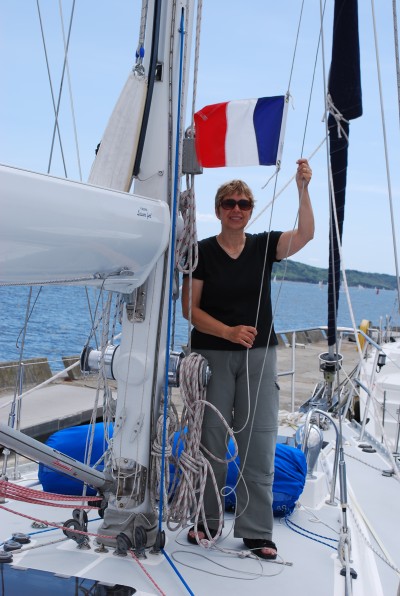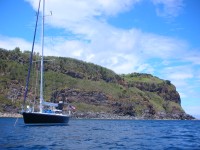
Aboard Aponivi
25 February 2011 | Charlestown, Nevis
29 December 2010 | Falmouth Harbor, Antigua
26 October 2010 | Palma
01 October 2010 | Ciutadella
19 September 2010 | Palma de Mallorca
07 September 2010 | Gibralter
28 August 2010 | Lagos
31 July 2010 | 41 22.34'N; 08 45.876'W
23 July 2010
16 July 2010
06 July 2010 | Brest
03 July 2010 | 54 13.424'N
25 June 2010 | Oban
25 June 2010 | Reported from Holyhead
08 June 2010 | Bngor Marina
08 June 2010 | Holyhead and Conway
31 May 2010 | Neyland, South Wales
13 April 2010
Aponivi arrive en France
06 July 2010 | Brest
by Lorraine

Lorraine raises the French courtesy flag on Aponivi
Our crossing of the English Channel -- from Falmouth, England to Brest in France -- was superb. Add an "e" and you get "superbe," a good word to describe our experience in French, too.
We left Falmouth, our beloved British "home away from home," around noon under sunny skies and with a 15 knot wind blowing from the northwest. After twenty miles, the Cornish coast was no longer visible. Howard bade farewell to the BBC and the London "Times." There will be no more English-speaking countries for the rest of the European cruising season.
Our beam reach was quite comfortable, although the 2 meter-high ocean swells kept both my arms busy and well exercised at the wheel. As night fell and the half moon rose, we furled the genoa sail and went on with just the main. At the rate we were going, about eight knots, we would otherwise have reached Brittany's rocky coast before sunrise.
Sleep came in no longer than one hour intervals. The commercial traffic was so heavy in the Channel that it demanded two sets of eyes: one at the wheel and the other at the navigation station, monitoring our AIS (Automatic Identification System) to see what our CPA (closest point of approach) would be if we maintained our course. At times, the AIS resembled a swarm of honey bees buzzing around Aponivi as she sat in the center of the hive. Fortunately, we didn't come close to being stung.
After 75 miles, the commercial traffic was behind us, and we soon caught our first glimpse of Ile d'Ouessant's lighthouse. Visible 30 miles away, it's one of the most powerful in the world, rising 70 meters from the island that has the Atlantic Ocean on its west and the start of the Channel on its east. As we neared the coast, another half dozen lighthouses came into view.
Next began a complicated piece of navigation through a narrow, rock-strewn passage called the Chenal du Four. Fortunately, our visibility was excellent. Howard had calculated our passage to occur near the end of the south-going tide so the current was kind to us. The Chenal du Four is generously buoyed, which is a good thing, but one red buoy caught me off guard. In my sleep-deprived state, I had forgotten that red and green buoys have a meaning here opposite from that in the states. Following the US rules, I nearly turned to port as I approched the buoy, toward the hazard it was meant to guard against. "Red, Right, Return," which reminds US boaters to keep red buoys to the right when returning to a port, is replaced here by "Green to Green," a reminder to keep green buoys and the green navigation lights on the right side of the boat, facing each other. Nigel Calder, author of many books about boating, has written that forgetting this difference is one of the easier ways by which American sailors can drown themselves in Europe.
I called Howard to the cockpit becuae the compass course he asked me to steer seemed to violate "Red, Right, Return." He quickly reminded me that we weren't in Long Island Sound anymore.
As we neared the Moulin Blanc Marina in Brest, I spoke French on the VHF radio for the first time, requesting docking instructions. I had rehearsed what I needed to say so many times that it sounded pretty good to me. I then hung our "defenses" (fenders) on the "babord" (port) side, tied our "amarres" (docking lines) to the" ponton" (pontoon) and reported to the marine office.
Later in the afternoon, I had to expand my French vocabulary to find a mechanic who could do a "nettoyage du rouet de turbocompresseur," (a cleaning of our engine's turbo-charge compressor) and to find a wire brush to clean our battery terminals. Reading "Madame Bocary" in Flaubert's melodic French did not prepare me for this.
We didn't pick Brest as our first French port of call for its charm. Our guide book says it has none, having been bombed into rubble in World War II and rebuilt with little grace. But the full-service marina presented an assured and easily managed dock space -- a top priority after an all-night sail across the Channel -- and its location amid beaches and woodlands beyond the city is quite nice. It is also lively, as we arrived in the middle of a week-long championship race series for windsurfers and small sailboats.
Stops in some of Brittany's more acclaimed rivers and bays will follow, although fewer than we would like. We need to cross the Bay of Biscay to reach Spain's Galicia before August storms set in. More immediately, we look forward to being gently rocked to a long, restoring sleep in the Rade (bay) de Brest.
Our crossing of the English Channel -- from Falmouth, England to Brest in France -- was superb. Add an "e" and you get "superbe," a good word to describe our experience in French, too.
We left Falmouth, our beloved British "home away from home," around noon under sunny skies and with a 15 knot wind blowing from the northwest. After twenty miles, the Cornish coast was no longer visible. Howard bade farewell to the BBC and the London "Times." There will be no more English-speaking countries for the rest of the European cruising season.
Our beam reach was quite comfortable, although the 2 meter-high ocean swells kept both my arms busy and well exercised at the wheel. As night fell and the half moon rose, we furled the genoa sail and went on with just the main. At the rate we were going, about eight knots, we would otherwise have reached Brittany's rocky coast before sunrise.
Sleep came in no longer than one hour intervals. The commercial traffic was so heavy in the Channel that it demanded two sets of eyes: one at the wheel and the other at the navigation station, monitoring our AIS (Automatic Identification System) to see what our CPA (closest point of approach) would be if we maintained our course. At times, the AIS resembled a swarm of honey bees buzzing around Aponivi as she sat in the center of the hive. Fortunately, we didn't come close to being stung.
After 75 miles, the commercial traffic was behind us, and we soon caught our first glimpse of Ile d'Ouessant's lighthouse. Visible 30 miles away, it's one of the most powerful in the world, rising 70 meters from the island that has the Atlantic Ocean on its west and the start of the Channel on its east. As we neared the coast, another half dozen lighthouses came into view.
Next began a complicated piece of navigation through a narrow, rock-strewn passage called the Chenal du Four. Fortunately, our visibility was excellent. Howard had calculated our passage to occur near the end of the south-going tide so the current was kind to us. The Chenal du Four is generously buoyed, which is a good thing, but one red buoy caught me off guard. In my sleep-deprived state, I had forgotten that red and green buoys have a meaning here opposite from that in the states. Following the US rules, I nearly turned to port as I approched the buoy, toward the hazard it was meant to guard against. "Red, Right, Return," which reminds US boaters to keep red buoys to the right when returning to a port, is replaced here by "Green to Green," a reminder to keep green buoys and the green navigation lights on the right side of the boat, facing each other. Nigel Calder, author of many books about boating, has written that forgetting this difference is one of the easier ways by which American sailors can drown themselves in Europe.
I called Howard to the cockpit becuae the compass course he asked me to steer seemed to violate "Red, Right, Return." He quickly reminded me that we weren't in Long Island Sound anymore.
As we neared the Moulin Blanc Marina in Brest, I spoke French on the VHF radio for the first time, requesting docking instructions. I had rehearsed what I needed to say so many times that it sounded pretty good to me. I then hung our "defenses" (fenders) on the "babord" (port) side, tied our "amarres" (docking lines) to the" ponton" (pontoon) and reported to the marine office.
Later in the afternoon, I had to expand my French vocabulary to find a mechanic who could do a "nettoyage du rouet de turbocompresseur," (a cleaning of our engine's turbo-charge compressor) and to find a wire brush to clean our battery terminals. Reading "Madame Bocary" in Flaubert's melodic French did not prepare me for this.
We didn't pick Brest as our first French port of call for its charm. Our guide book says it has none, having been bombed into rubble in World War II and rebuilt with little grace. But the full-service marina presented an assured and easily managed dock space -- a top priority after an all-night sail across the Channel -- and its location amid beaches and woodlands beyond the city is quite nice. It is also lively, as we arrived in the middle of a week-long championship race series for windsurfers and small sailboats.
Stops in some of Brittany's more acclaimed rivers and bays will follow, although fewer than we would like. We need to cross the Bay of Biscay to reach Spain's Galicia before August storms set in. More immediately, we look forward to being gently rocked to a long, restoring sleep in the Rade (bay) de Brest.
Comments
| Vessel Name: | Aponivi |
| Vessel Make/Model: | Apogee 50 |
| Hailing Port: | New York, NY |
| Crew: | Howard and Lorraine Veisz |
Gallery not available

Who: Howard and Lorraine Veisz
Port: New York, NY